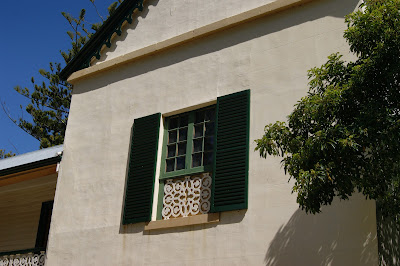Commandant Charles Booth moved into the four room cottage in 1833. It was surrounded by a verandah closed in by green venetian blinds. A separate kitchen was connected to the house via a covered walkway. By March 1837, the original kitchen had been converted into an office for Booth and a new kitchen had been constructed. Commandant Booth married in 1838 and by 1839 the first major additions had been made to the rear of the cottage. The main entrance was still on the western verandah but then went into a small entrance hall. Stables were also added following Commandant Booth’s request for a building to accommodate visitor’s horses.
Around 1854, the then commandant, James Boyd, made additions to the house that resulted in the enclosure of the area between the 8 room house and the kitchen constructed by William Champ. He converted the kitchen to servant’s accommodation, added servants quarters to the rear and had yet another kitchen constructed. He also added the porch on the entrance steps and rendered the front of the house to look like stone. Although there were many more minor changes over the next 140 years, the house today looks pretty much as it did in the 1850’s.
The garden around the Commandant’s House has been a feature from the earliest days of the settlement. Commandants Booth & Champ were both keen gardeners and imported a wide range of ornamental & useful plants. When the house was used by two bachelor officers, the gardens became neglected and it wasn’t till Commandant James Boyd took office in 1853, that the gardens were once again cultivated. Visitors to the site during this period commented on the “luxuriant & sweet smelling garden and shrubberies.” Work continues today to maintain the gardens around the Commandant’s House and to show how styles and features have changed over the years.
As part of the move to preserve Port Arthur’s historic buildings the Government acquired the Carnarvon Hotel in 1939. It was later managed by the Scenery Preservation Board who managed other buildings and rented it out as a private residence pending a program of renovation and restoration. However, only small repairs were ever undertaken and successive residents used less and less of the house. By 1972, the house was declared unfit for habitation.
Between 1981 & 1985 this building, along with others on the site were restored during the Port Arthur Conservation & Development Program. The conservation and interpretation is an on going project and the Commandant’s House is now the most visited house museum on site and the interpretation is really well done and tells its history over the years.
Main Text & Information Sources –
Interpretation Signs at the site.


























